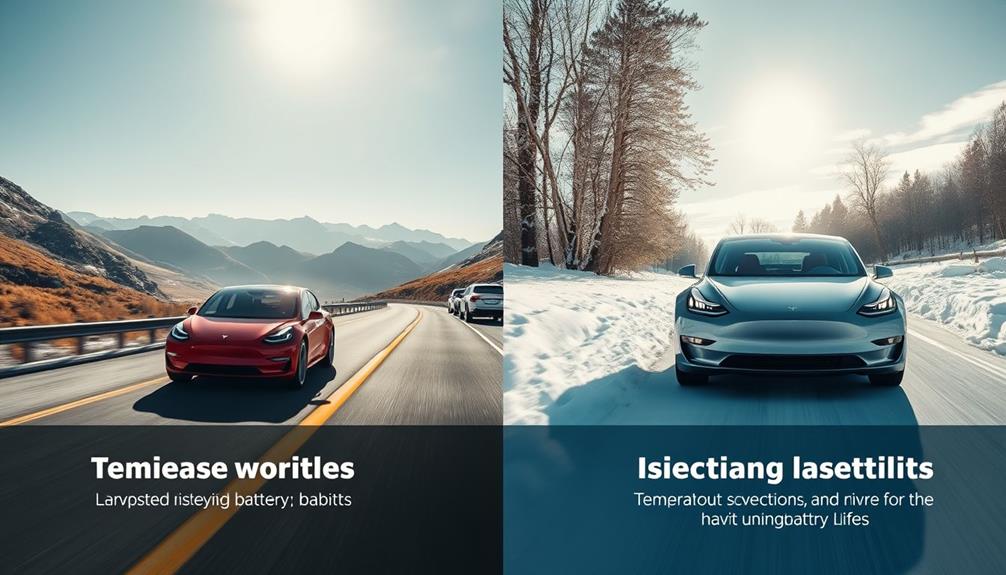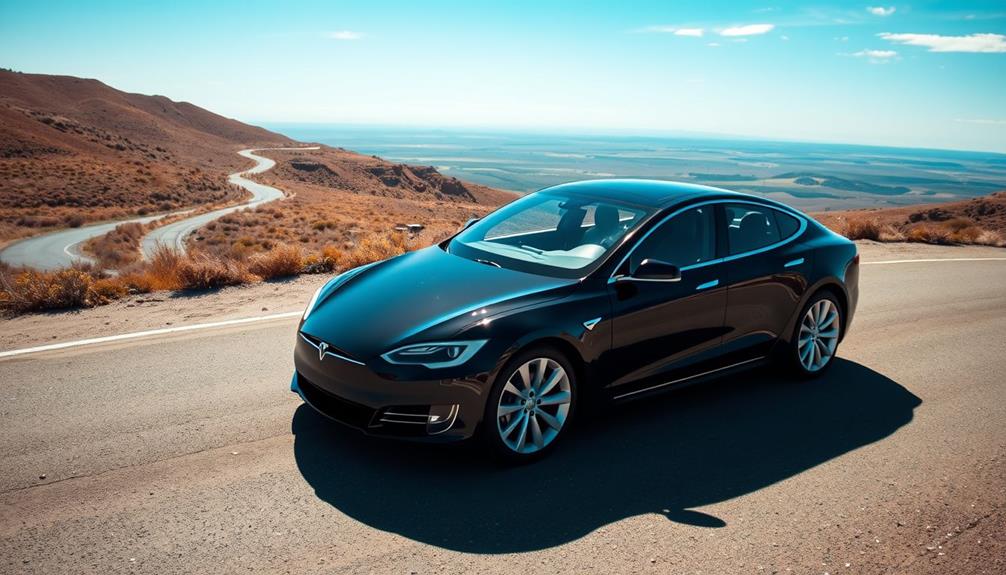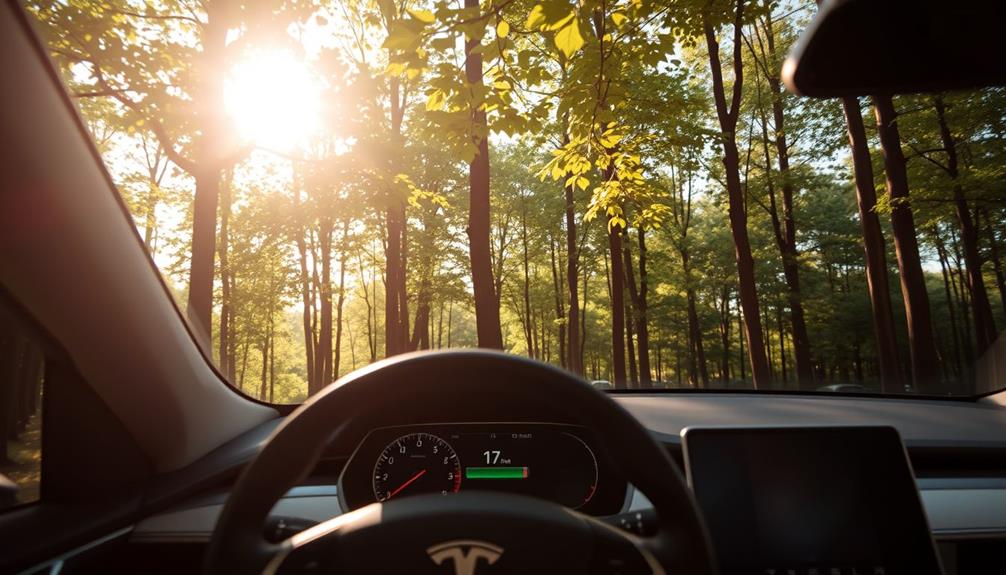In a Tesla, you can expect to travel between 250 and over 400 miles without recharging, depending on the model you choose. Factors like your driving habits, weather conditions, and battery management all influence your range. For instance, avoiding aggressive acceleration and maintaining a moderate speed can help you go further. Additionally, charging your vehicle between 20% and 80% boosts battery life, while the sleep mode feature minimizes drain when parked for longer periods. If you're curious about maximizing your Tesla's range and understanding more about battery care, there's plenty more to explore.
Key Takeaways
- Tesla battery ranges vary by model, with the Model S offering up to 405 miles and the Model Y Performance around 303 miles on a full charge.
- Consistent charging between 20% and 80% enhances battery longevity, allowing for maximum driving range over time.
- Cold temperatures can reduce battery range by up to 40%, impacting how far you can drive before recharging.
- Driving habits, such as aggressive acceleration, can drain the battery faster, reducing the distance you can travel without a charge.
- Utilizing Tesla's regenerative braking can extend your driving range, allowing for longer trips without needing to recharge frequently.
Tesla Battery Lifespan

When you drive a Tesla, you're not just getting an electric vehicle; you're investing in a battery designed for impressive longevity.
Tesla batteries boast an expected lifespan ranging from 300,000 to 500,000 miles, which translates to roughly 22 to 37 years for the average driver. This remarkable battery lifespan means you can enjoy years of reliable performance without constantly worrying about Tesla battery replacement.
Battery degradation is a natural process, but it's minimal in Teslas. On average, you'll see about 10% degradation after 100,000 miles, followed by an additional 1% per year under ideal conditions.
This slow rate of degradation helps guarantee that your Tesla retains substantial capacity over time. Plus, with an 8-year warranty covering all Tesla models, you can rest assured that your battery will maintain at least 70% of its capacity during this period.
Many Tesla owners find that their vehicles last long enough that they never need a battery replacement, highlighting the durability of these batteries.
Notable examples, like a Model S owner who drove over a million miles, further showcase the impressive longevity you can expect from your Tesla battery.
Factors Affecting Battery Life

When it comes to your Tesla's battery life, your charging habits play a vital role in how long it lasts.
You'll also notice that driving conditions, like weather and your driving style, can impact performance and range.
Plus, different Tesla models have varying capacities, which means battery longevity can differ from one vehicle to another.
Charging Habits Impact Longevity
Charging habits play an important role in extending the life of your Tesla's battery. By consistently charging your battery between 20% and 80%, you enhance its lifespan and greatly reduce battery degradation.
It's best to avoid charging to 100% regularly, as this can stress your battery and lead to faster wear. Daily charging to around 90% is recommended for improved battery longevity, while keeping the charge above 10% prevents deep discharges that can harm battery health.
To further support your battery, consider utilizing smart charging features. These tools help manage your energy use effectively, ensuring your battery stays within the ideal charge range.
Additionally, maintaining an ideal battery temperature of 20°C to 25°C (68°F to 77°F) is vital, as it can minimize degradation rates and enhance overall performance.
Driving Conditions Influence Performance
Driving conditions can greatly affect your Tesla's battery performance and overall efficiency. Your driving style plays a significant role; aggressive acceleration and high speeds can quickly drain your battery, reducing your overall mileage per charge.
Weather conditions also have a big impact—cold temperatures can decrease your battery range by up to 40%, while warmer weather generally improves efficiency.
Additionally, vehicle aerodynamics matter. If you have a roof rack or drive with your windows down, you're increasing drag and decreasing range.
The terrain you navigate also influences battery life; driving uphill consumes more energy, whereas downhill drives can utilize regenerative braking to extend your range.
Lastly, don't forget about climate control features. Using heating or air conditioning can cut your battery range by up to 20%, depending on the settings and outside temperatures.
Model Variations in Range
Different Tesla models deliver varying ranges, influenced by several key factors. The battery capacity of each model plays an essential role in determining how far you can go on a single charge. Here's a quick overview of the range and battery capacity of popular Tesla Models:
| Tesla Model | Range (miles) | Battery Capacity (kWh) |
|---|---|---|
| Model S | 405 | 98 |
| Model 3 | 267 | 80.5 |
| Model Y Performance | 303 | 75 |
| Cybertruck | 500 | TBD |
While the Cybertruck boasts the longest range, all models have unique strengths. Factors like driving style, weather conditions, vehicle aerodynamics, weight, and terrain can considerably impact the effective range you experience. For instance, aggressive acceleration or driving in extreme weather can reduce your overall range. Understanding how these variables affect your Tesla's performance will help you maximize battery life and minimize the need for frequent recharging. By choosing the right model and being mindful of your driving habits, you can enjoy the full benefits of Tesla's innovative electric vehicles.
Model-Specific Battery Range

When choosing a Tesla, you'll notice significant differences in battery range across models.
The Model S leads with up to 405 miles, while options like the Model 3 and Model X offer less, each tailored for different needs.
Understanding these model-specific ranges and the factors that influence them can help you make an informed decision.
Model-Specific Range Comparison
How do Tesla models stack up in terms of battery range?
When it comes to battery life, the Tesla Model S leads the pack, delivering an impressive 405 miles on a single charge with its robust 98 kWh battery.
If you're looking for something more compact, the Model 3 offers about 267 miles, making it perfect for your daily commutes or short trips around town.
The Model X, while spacious, provides a slightly lower range of around 250 miles due to its 70 kWh battery.
If versatility is what you need, the Tesla Model Y Performance strikes a balance, giving you an estimated range of 303 miles, ideal for both city driving and weekend road trips.
Looking ahead, the upcoming Cybertruck is generating buzz with its anticipated capability of up to 500 miles on a single charge, catering to those who require extended range for work or leisure.
Each model serves different needs, so whether you're commuting, road-tripping, or working, there's a Tesla that fits your lifestyle perfectly.
Factors Affecting Range
Battery range in Tesla models is influenced by several key factors, each playing a significant role in how far you can travel on a single charge.
For instance, the Tesla Model S boasts the longest range at approximately 405 miles thanks to its robust 98 kWh battery. In contrast, the Model 3 offers a range of about 267 miles with its 80.5 kWh battery, while the Model Y Performance can take you around 303 miles, making it ideal for longer trips.
The Model X, equipped with a smaller 70 kWh battery, provides a range of approximately 250 miles. The Cybertruck stands out with a potential range of up to 500 miles, showcasing the advancements in battery technology.
Your driving habits and terrain also impact battery life. Frequent acceleration and hilly routes can drain your battery faster, reducing your overall range.
Additionally, the availability of charging stations on your route is essential. Planning your journey around charging stations guarantees you won't run out of battery, maximizing your Tesla experience.
Understanding these factors will help you make the most of your Tesla's range.
Charging Practices for Longevity

To maximize your Tesla's battery life, aim to keep the charge between 20% and 80%. This range is essential for maintaining battery health and longevity. Regularly charging to 100% can increase stress on the battery, so reserve that for long trips.
Instead, prioritize daily charging practices that stay within the ideal range. Frequent deep discharges below 20% can negatively impact your battery lifespan. To combat this, charge your vehicle regularly to keep it in a healthy state of charge.
Utilizing smart charging features can also help manage energy use, ensuring you're not overcharging or discharging excessively. Additionally, pay attention to battery temperature.
Keeping it between 20°C to 25°C (68°F to 77°F) is important for minimizing degradation. If you charge your Tesla in extreme temperatures, it can lead to reduced battery performance and longevity.
Battery Sleep Mode Benefits

Utilizing sleep mode in your Tesla offers significant benefits, especially for those who don't drive their vehicle regularly. By enabling this feature, you can drastically reduce battery drain and extend the time between charges.
When your Tesla enters sleep mode, it can remain uncharged for 60-70 days, and under ideal conditions, even up to 100 days with a full charge.
Here are a few key benefits of sleep mode:
- Minimized battery drain: In sleep mode, your Tesla battery only loses about 1-2% of its charge per day.
- Extended downtime: Sleep mode allows you to enjoy longer periods of inactivity without worrying about a depleted battery.
- Cost-effective: By preventing your battery from completely dying, sleep mode helps you avoid costly repairs.
It's recommended to keep your Tesla plugged in during long periods of inactivity to maintain ideal battery health.
With sleep mode activated, you can have peace of mind knowing your Tesla battery is protected while you take a break from driving.
Charging Costs and Times

Considering the diverse charging options available, understanding the costs and times associated with charging your Tesla is essential for effective planning. Charging costs can range from $8.50 to $20 per charge, depending on your model and where you charge.
Here's a quick overview of charging times for different Tesla models:
| Model | Charging Time | Charging Costs |
|---|---|---|
| Model S | ~50 hours | $15 – $20 |
| Model 3 | ~11 hours | $8.50 – $15 |
| Model X | 10 – 12 hours | $10 – $18 |
If you're on the go, Tesla Superchargers are a great option. They can recharge up to 80% of your battery in about 30 minutes, making them ideal for long trips. With over 30,000 Supercharger stations worldwide, you'll find plenty of fast charging options. Home charging, on the other hand, varies based on your outlet's circuit capacity, generally adding 10-44 miles of range per hour. Consequently, knowing these charging costs and times helps you optimize your Tesla experience.
Replacement Costs Overview

When it comes to Tesla battery replacement, costs can be a significant factor for owners. Depending on your model and battery pack size, you could be looking at replacement costs ranging from $13,000 to $20,000.
If you need to replace individual battery modules, that'll typically run you between $5,000 and $7,000, but don't forget to factor in additional costs for parts and labor, which can elevate the total bill.
Here are some key points to keep in mind:
- Labor costs can climb to $175 per hour, adding to the overall expenses.
- Warranty coverage often protects against early battery failures, but once that's expired, you'll bear the full brunt of replacement costs.
- If multiple modules need replacing, you could face expenses escalating to $20,000 to $30,000.
Understanding these replacement costs is essential for planning ahead.
While Tesla's batteries are built to last, being aware of potential expenses can help you make informed decisions about your electric vehicle ownership.
Tips for Maximizing Range

Maximizing your Tesla's driving range is essential for getting the most out of each charge. To enhance battery life, aim to charge your vehicle between 20% and 80%. Frequent charging to 100% can stress the battery and lead to degradation over time.
Utilizing regenerative braking is another effective strategy; it captures kinetic energy during braking, allowing you to extend your driving range while reducing energy consumption.
Driving at moderate speeds and engaging eco-friendly driving modes can greatly improve your range. Aggressive acceleration and high speeds drain your battery faster, so adopting a gentler driving style pays off.
Additionally, maintaining ideal tire pressure and ensuring regular maintenance helps your Tesla run efficiently, maximizing the distance you can travel on a single charge.
Be mindful of environmental factors too. Colder temperatures can reduce battery efficiency by up to 20%, and using climate control features can further decrease your overall range.
Frequently Asked Questions
How Long Does a Tesla Battery Last Without Charging?
A Tesla battery can last anywhere from 60 to 100 days without charging, depending on settings and conditions. However, you should regularly monitor charge levels to avoid potential issues from prolonged inactivity. Tesla charging time is relatively quick, with the ability to fully charge a battery in about an hour using a Supercharger. It is recommended to utilize a Supercharger or home charger to keep your Tesla battery at an optimal level. By staying on top of the Tesla charging time and regularly monitoring your battery levels, you can ensure that your Tesla stays operational for longer periods of time.
How Far Can a Tesla Go Without Recharging?
Depending on the model, you can travel anywhere from 272 to 500 miles on a single charge. Your driving style and the terrain will impact how far you actually go before needing to recharge.
Can I Leave My Tesla Unplugged for 2 Weeks?
Yes, you can leave your Tesla unplugged for two weeks, but expect about 14-28% battery loss. To maintain battery health, keep at least 20% charge and consider plugging it in for long periods.
How Long Can You Drive a Tesla Before Recharging?
You can drive a Tesla for quite a distance before needing to recharge. Depending on the model, you might cover 272 to 500 miles, making it perfect for several days of driving without worrying.
Conclusion
In the world of electric vehicles, Tesla stands out for its impressive battery life, yet it's essential to remember that factors like driving habits and charging practices can tip the scale. While you can enjoy long drives without frequent stops, neglecting battery care might lead to unexpected limitations. Balancing your charging routine with smart driving choices guarantees you maximize your Tesla's potential. Embrace the journey, but keep an eye on that battery—your adventure depends on it!










